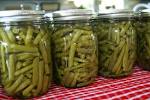Canning season started and the Family and Consumer Agents from Extension are setting classes to encourage people to follow some basic safety guidelines. The first of these is to use recipes and processes that have been scientifically tested. The So Easy to Preserve book is the basic resource for canning, freezing and dehydrating, and has the added convenience of having a strong index. You can start there to determine ![IMG_8931a[1]](https://bilingualopinions.wordpress.com/wp-content/uploads/2015/04/img_8931a1.jpg?w=150&h=95) which possible methods exist for a given item: If it is listed, there is a recommendation, but if it isn’t listed, that option does not have a tested recipe or procedure.
which possible methods exist for a given item: If it is listed, there is a recommendation, but if it isn’t listed, that option does not have a tested recipe or procedure.
There are number of sources for canning information that really cannot be relied upon, including: Websites, Blogs, Many current books, and Celebrity chefs. You definitely want to avoid using old recipes, even those in recently re-published old cookbooks, because canning recommendations have changed over the years, and are subject to significant updates when new science determines that safety is at stake.
Because of this, it’s important to be careful about taking advice from other home canners, especially those that canned many years ago or were exposed to canning at a young age, because they may have learned an older forms of canning—open kettle, steam canning, turning the jars upside down, etc.—and never updated their knowledge of the subject. Just because “No one ever died” from those methods does not mean that they are smart to use, or that no one ever will.
Now that you’ve chosen a recipe from the So Easy to Preserve, it is very important to take a few more steps to ensure the safety of your end product.
- You must follow recipes and procedures carefully. If the directions say to peel and chop, you must peel and chop. If it says to process 30 minutes for pint jars, then you must use pint jars and process for thirty minutes. Canning, especially, is not a spot where we get to have our culinary genius shine through. It’s important for your safety that you do not deviate from the recipe for what goes into the jar or skip steps in the process. Later, when you take the jar out of the pantry and include it as part of meal, you can use it creatively then.
- The ingredients you use for any food preservation method need to be the best quality, ripe but not overripe, and never picked up from the ground. Food preservation methods won’t make bad food better and food already on its way to spoiling has a greater likelihood of spoiling once preserved.
- As with all kitchen activities, cleanliness is important. Thoroughly clean any produce and containers that will be used, and work in a clean work area with clean hands and utensils.
Canning is an important and enjoyable way to preserve food. And it is very safe if it is done correctly. To read more about safety canning and preserving visit The National Center for Home Food Preservation web site http://nchfp.uga.edu/ You will find information about the So Easy to Preserve book, webinars, recipes, and self-studies.
![images[4]](https://bilingualopinions.wordpress.com/wp-content/uploads/2015/01/images4.jpg?w=150&h=74)
![salad-istock-TaylorLittle[1]](https://bilingualopinions.wordpress.com/wp-content/uploads/2014/07/salad-istock-taylorlittle1-e1404828132954.jpg?w=150&h=127)


